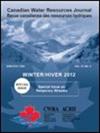Using artificial neural networks to estimate snow water equivalent from snow depth
IF 0.9
4区 环境科学与生态学
Q3 WATER RESOURCES
引用次数: 9
Abstract
Abstract Snow water equivalent (SWE) is among the most important variables in the hydrological modelling of high latitude and mountainous areas. While manual snow surveys can directly provide SWE measurements, they are time consuming and costly, especially compared to automated snow depth measurements. Moreover, SWE is strongly correlated to snow depth. For this reason, several empirical equations relating snow depth to SWE have been proposed. The present study investigates the potential of artificial neural networks for estimating SWE from snow depth and commonly available data, and the proposed method is compared to existing, regression-based methods. An ensemble of multilayer perceptrons is constructed and trained using gridded meteorological variables and a data set of almost 40,000 SWE and depth measurements from the province of Quebec (eastern Canada). Overall, the proposed artificial neural network-based method reached a RMSE of 28 mm and outperforms by 17% a series of empirical equations for estimating the SWE of an independent set of measurement sites. Nevertheless, all the tested methods demonstrated limits to estimate lowest values of snow bulk density.利用人工神经网络从雪深估算雪水当量
摘要雪水当量是高纬度山区水文模拟中最重要的变量之一。虽然手动雪测量可以直接提供SWE测量,但它们耗时且成本高昂,尤其是与自动雪深测量相比。此外,SWE与雪深有很强的相关性。因此,已经提出了几个将雪深与SWE相关的经验方程。本研究调查了人工神经网络根据雪深和常用数据估计SWE的潜力,并将所提出的方法与现有的基于回归的方法进行了比较。使用网格气象变量和魁北克省(加拿大东部)近40000个SWE和深度测量的数据集,构建和训练了一个多层感知器集合。总体而言,所提出的基于人工神经网络的方法达到了28的RMSE mm,并且优于一系列用于估计一组独立测量位点的SWE的经验方程17%。尽管如此,所有测试方法都证明了估计雪体积密度最低值的局限性。
本文章由计算机程序翻译,如有差异,请以英文原文为准。
求助全文
约1分钟内获得全文
求助全文
来源期刊

Canadian Water Resources Journal
WATER RESOURCES-
CiteScore
2.90
自引率
5.90%
发文量
17
审稿时长
>12 weeks
期刊介绍:
The Canadian Water Resources Journal accepts manuscripts in English or French and publishes abstracts in both official languages. Preference is given to manuscripts focusing on science and policy aspects of Canadian water management. Specifically, manuscripts should stimulate public awareness and understanding of Canada''s water resources, encourage recognition of the high priority of water as a resource, and provide new or increased knowledge on some aspect of Canada''s water.
The Canadian Water Resources Journal was first published in the fall of 1976 and it has grown in stature to be recognized as a quality and important publication in the water resources field.
 求助内容:
求助内容: 应助结果提醒方式:
应助结果提醒方式:


